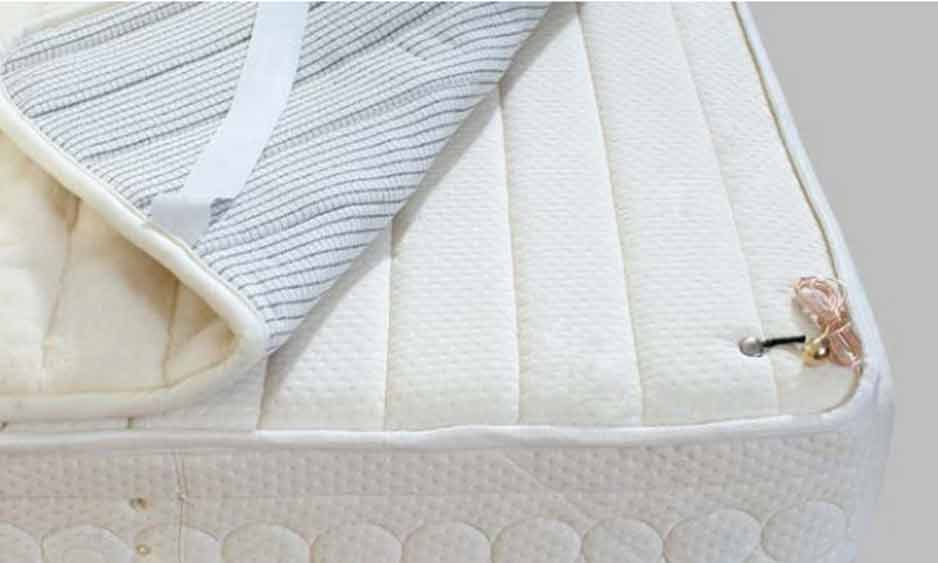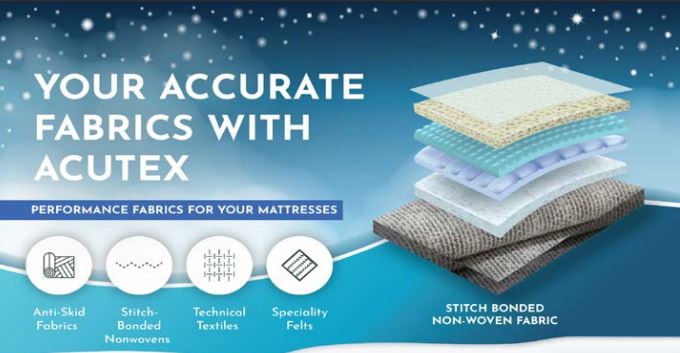
A simple yet powerful statement: As important as skin to the body. That is how mattress ticking has come to be seen in the larger realm of the modern mattress industry. It is no longer a simple covering meant to hold feathers or fillers that were formerly used to make a mattress. It has become an integral part of sleep science and technology, thus adding value through textile innovation. Another observation worth mentioning is that its development has been as drastic as purposeful over the years.
A good mattress ticking is comfortably soft, skin-friendly and durable, besides offering the manufacturer a competitive advantage through its design and aesthetics. A closer look at its functions should help us better understand the role it plays in driving mattress sales.
Getting the basics right: durable & flexible
From multiple spilling accidents to bouncing kids to moody weather, a mattress endures a lot. Thus the very obvious and practical use of mattress fabric or ticking is to help keep the shape of the mattress intact and to protect the materials inside from exposure to light, solvents, dust or other elements that can oxidise them or fasten the process of deterioration.
It ensures that the quality of the mattress and the resulting sleep is maintained to max, throughout the period of 7-8 years or as affirmed by the manufacturer. Thus the quality of the ticking and the mattress are supposed to be always in a complementary relationship. In the words of Mr. Pooviah “The cause is lost the moment the quality of the mattress fabric is compromised.” His is a renowned firm, Jacquard fabrics, engaged in both manufacturing and export, and serving some of the industry’s best mattress firms.
Besides durability, elasticity is another equally crucial element. Fabrics tend to vary widely in elasticity, with knitted fabrics showing more elasticity than their woven counterparts. Flexible fabrics facilitate the process of underlying layers forming a cradle and relieving pressure. How tightly the fabric is attached and not just made, both factors exert influence.
Comfy and cosy!
Besides contributing to the luxury, performance, durability, the aesthetic appeal of the mattress, ticking also plays a vital role in the breathability of the outer layers as well as aid in temperature regulation.
An average person would perspire 250 ml of sweat every night. Even if a quilt of about 3cm is placed, most of the sweat will be absorbed by the mattress. Thus a mattress fabric that is not hygroscopic and breathable, is more likely to help breed bacteria and mites. In terms of breathability and moisture and temperature regulation, fabrics made with natural fibres tend to outperform fabrics made with synthetic fibres. Some fabrics also have special additives to help control temperature and moisture for those who tend to sleep hot.
The mattress fabric plays an important role in manufacturing a good quality, comfortable and durable mattress. The mattress fabrics are changing according to the industry and market needs. The key aspects that drive the mattress fabric industry are durability, comfortness, asthetics, cost, and quantity
Thus best mattress ticking fabrics are made of high-quality woven or knit materials that are flexible, durable, comfortable, and breathable and will allow the underlying layers to do the job they were designed to do.
As customers expect more from everyday products, providing the bare minimum doesn’t cut the chase anymore. Another industry veteran, Mr. Alok Tewari, Regional Commercial Director of Milliken & Company points out “Consumers have expectations from a mattress ticking on many levels, be it fire protection, anti-microbial or stain free properties. Consequently the mattress brands are combining many benefits to provide a surface that ensures a good night, stress-free sleep.”
Mattress ticking is no more seen as a mere surface to sleep on. They are expected to add value, by facilitating the process of sleep itself and ensuring that the best possible quality of sleep is achieved persistently and without much deterioration over the years.
Aesthetics game on point
As we move a step ahead of looking at only the utilitarian aspect of everyday products, the aesthetic appeal of things is occupying a greater part of our imagination. Design is an aspect that holds the potential of landing a competitive advantage for brands. After all, human eyes will never cease to be smitten by visually appealing things.
Wrinkle-resistant fabrics make for a good option. They can make all the difference on a showroom floor while also being equipped to handle the ruffle of boxed beds or alternate packaging methods as well as shipping and warehousing. In the age of the internet, customers buy with their eyes first. Manufacturers seek fabrics that photograph well, “pop” on screen and convey a “visual softness” that appeals to shoppers buying online.

The design also acts as a stand-out factor for branding. The rectangular shapes and relatively standard sizes don’t leave much scope for visual storytelling for branding. Thus fabric designs offer a good opportunity to create a distinguished and recognizable brand image.
The range
Cheaper mattress covers usually zip on polyester ones that can bobble and warp over time. More high-end mattresses feature natural fibres which are more breathable and longlasting. The depth and grams per square metre (GSM) of the fabric helps assess its quality and density. Opting for a higher GSM fabric results in a thicker and higher quality fabric than a lower GSM count. Lower GSMs such as 100g will soon flatten and will stop providing that additional comfort layer. However as Mr. Pooviah points out “True quality shouldn’t be compromised, while at the same time diversity and range are integral to any industry, specially in India.”
Depending on the sleeper’s needs and habits, their preference also varies to a great extent. Like a placebo effect, some people do sleep better on antibacterial fabrics because they feel more comfortable and relaxed with the idea of a cleaner surface.
Sustainable fabrics are also gaining much popularity because people feel more comfortable sleeping on natural surfaces that have been harvested without the use of fertiliser and pesticide and manufactured in a GOTS-certified facility. Recycled and ‘upcycled’ polyesters provide comfort and a better conscience because of their association with recycling and ocean cleaning. While copper fabrics are adored for their bacteria-killing power and pain-relief properties.
This awareness amongst customers in combination with manufacturers’ shared interest in diversifying the ticking range has pushed the industry to innovate. For example, Outlast and Coolmax are high-wicking fabrics that claim they can help remove some of the heat issues in memory foam. Jacquard also boasts of their GOTS-certified natural fibres as well recycled material that has helped keep 7.50 lakhs plastic bottles from ending up in landfills or oceans.

